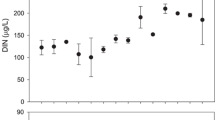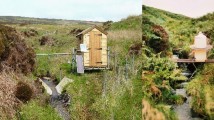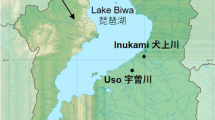Abstract
Our study was designed to assess the relative importance of algae and bacteria as sources of energy for stream macroinvertebrates. In one experiment, we manipulated algae by artificially shading six sections in each of two streams, one stream with an open canopy (clear-cut drainage basin) and the other with a closed canopy (forested drainage basin); both streams were in Hubbard Brook Experimental Forest, New Hampshire, USA. Chlorophyll a concentrations were reduced from 0.2 to 0.05 μg/cm2 in artificially shaded sections of both streams. However, macroinvertebrates showed no response to these algal manipulations in either the clear-cut or forested stream. Nutrient concentrations (N and P) were low and limiting to primary production in both the clear-cut and forested streams. Additionally, both streams had relatively low macroinvertebrate densities suggesting bottom-up controls were important in macroinvertebrate abundance. However, the forested stream did have higher macroinvertebrate densities presumably because of higher inputs of coarse particulate organic matter from the riparian vegetation. In a second experiment, in Augusta Creek, Michigan, we manipulated both algae and bacteria. To reduce algae, we artificially shaded experimental stream channels so that chlorophyll a was reduced from natural levels of 3.0–5.6 to 0.4–0.7 μg/cm2. Half of the shaded channels had dissolved organic carbon (DOC – sucrose) dripped into them to raise DOC levels by 2–3 mg/l and thus stimulate bacterial abundance. Open channels, with higher algal abundance, had higher densities of Ephemerella, but only in November when nymphs were larger. Channels with increased DOC had higher bacterial abundances, higher densities of Chironomidae and lower densities of Heptageniidae. Several other macroinvertebrate taxa that were at relatively low abundance in our samples showed no significant response to these manipulations. Our results suggest that early instar Ephemerella may not rely as heavily on algae as later instars. Also, certain taxa were able to use the heterotrophic microbial community, especially chironomids which increased in numbers when bacterial density increased; thus, the bacterial carbon source may be more important to some stream macroinvertebrates than previous studies have suggested.
Similar content being viewed by others
References
Behmer, D. J. & C. P. Hawkins, 1986. Effects of overhead canopy on macroinvertebrate production in a Utah (USA) stream. Freshwater Biology 16: 287–300.
Benke, A. C., 1998. Production dynamics of riverine chironomids: extremely high biomass turnover rates of primary consumers. Ecology 79: 899–910.
Benke, A. C. & D. I. Jacobi, 1994. Production dynamics and resource utilization of snag-dwelling mayflies in a blackwater river. Ecology 75: 1219–1232.
Benke, A. C. & J. B. Wallace, 1980. Trophic basis of production among net-spinning caddisflies: implications for food web analysis. Ecology 61: 108–118.
Benke, A. C. & J. B. Wallace, 1997. Trophic basis of production among riverine caddisflies: implications for food web analysis. Ecology 78: 1132–1145.
Bormann, F. H. & G. E. Likens (eds), 1979. Pattern and Process in a Forested Ecosystem. Springer-Verlag, New York.
Bourassa, N. & A. Cattaneo, 1998. Control of periphyton biomass in Laurentian streams (Quebec). Journal of the North American Benthological Society 17: 420–429.
Brown, G. W., A. R. Gahler & R. B. Marston, 1973. Nutrient losses after clear-cut logging and slash burning in the Oregon Coast Range. Water Resources Research 7: 1189–1199.
Couch, C. A. & J. L. Meyer, 1992. Development and composition of the epixylic biofilm in a blackwater river. Fresh-water Biology 27: 43–51.
Couch, C. A., J. L. Meyer & R. O. Hall Jr, 1996. Incorporation of bacterial extracellular polysaccharide by black fly larvae (Simuliidae). Journal of the North American Benthological Society 15: 289–299.
Decho, A. W., 1990. Microbial exopolymer secretions in ocean environments: their role(s) in food webs and marine processes. Oceanography & Marine Biology 28: 73–153.
Edwards, R. T. & J. L. Meyer, 1987. Bacteria as a food source for black fly larvae in a blackwater river. Journal of the North American Benthological Society 6: 241–250.
Edwards, R. T. & J. L. Meyer, 1990. Bacterivory by depositfeeding mayfly larvae (Stenonema spp.). Freshwater Biology 24: 453–462.
Feminella, J. W. & C. P. Hawkins, 1995. Interactions between stream herbivores and periphyton: a quantitative analysis of past experiments. Journal of the North American Benthological Society 14: 465–509.
Feminella, J. W., M. E. Power & V. H. Resh, 1989. Periphyton responses to invertebrate grazing and riparian canopy in 3 northern California coastal streams. Freshwater Biology 22: 445–457.
Findlay, S., K. Howe & D. Fontvieille, 1993. Bacterial-algal relationships in streams of the Hubbard Brook Experimental Forest. Ecology 74: 2326–2336.
Finlay, J. C., M. E. Power & C. Cabana, 1999. Effects of water velocity on algal carbon isotope ratios: implications for river food web studies. Limnology & Oceanography 44: 1198–1203.
Fuller, R. L. & C. Desmond, 1997. Influence of food quality on the growth of early and late instars of three mayfly (Ephemeroptera) species. Archiv für Hydrobiologie 131: 161–173.
Fuller, R. L. & T. J. Fry, 1991. The influence of temperature and food quality on the growth of Hydropsyche betteni (Trichoptera) and Simulium vittatum (Diptera). Journal of Freshwater Ecology 6: 75–86.
Fuller, R. L. & R. J. Mackay, 1981. Effects of food quality on the growth of three Hydropsyche species (Trichoptera: Hydropsychidae). Canadian Journal of Zoology 59: 1133–1140.
Fuller, R. L., J. A. Roelofs & T. J. Fry, 1986. The importance of algae to stream insects. Journal of the North American Benthological Society 5: 290–296.
Fuller, R. L., T. J. Fry & J. A. Roelofs, 1988. Influence of different food types on the growth of Simulium vittatum (Diptera) and Hydropsyche betteni (Trichoptera). Journal of the North American Benthological Society 7: 197–204.
Geesey, R. M., J. W. Costerton & R. B. Green, 1978. Sessile bacteria: an important component of the microbial population in small mountain streams. Limnology & Oceanography 23: 1214–1223.
Hall, R. O., 1995. The use of a stable carbon isotope addition to trace bacterial carbon through a stream. Journal of the North American Benthological Society 14: 269–277.
Hall, R. O. & J. L. Meyer, 1998. The trophic significance of bacteria in a detritus-based stream food web. Ecology 79: 1995–2012.
Hall, R. O., J. B. Wallace & S. L. Eggert, 2000. Organic matter flow in stream food webs with reduced detrital resource base. Ecology 81: 3445–3463.
Hall, R. O., G. E. Likens & H. M. Malcolm, 2001. Trophic basis of invertebrate production in 2 streams at the Hubbard Brook Experimental Forest. Journal of the North American Benthological Society 20: 432–447.
Hamilton, S. K. & W. M. Lewis Jr, 1992. Stable carbon and nitrogen isotopes in algae and detritus from the Orinoco River floodplain, Venezuela. Geochimica et Cosmochimica Acta 56: 4237–4246.
Hauer, F. R. & A. C. Benke, 1987. Influence of temperature and river hydrograph on black fly growth rates in a subtropical, blackwater river. Journal of the North American Benthological Society 6: 251–261.
Hepinstall, J. A. & R. L. Fuller, 1994. Periphyton reactions to different light and nutrient levels and the response of bacteria to thee manipulations. Archiv fürHydrobiologie 131: 161–173.
Hershey, A. E., R. W. Merritt, M. C. Miller & J. S. McCrea, 1996. Organic matter processing by larval blackflies in a temperate woodland stream. Oikos 75: 524–532.
Hobbie, J. E., R. J. Daley & S. Jasper, 1977. Use of nucleopore filters for counting bacteria by fluorescence microscopy. Applied Environmental Microbiology 33: 1225–1228.
Huryn, A. R., R. H. Riley, R. G. Young, C. J. Arbuckle, K. Peacock & G. Lyons. 2001. Temporal shift in contribution of terrestrial organic matter to consumer production in a grassland river. Freshwater Biology 46: 213–226.
Jahn, A. & P. H. Nielsen, 1998. Cell biomass and exopolymer composition in sewer biofilms. Water, Science & Technology 37: 17–24.
Junger, M. & D. Planas. 1994. Quantitative use of stable carbon isotope analysis to determine the trophic base of invertebrate communities in a boreal forest lotic system. Canadian Journal of Fisheries & Aquatic Sciences 51: 52–61.
Kaplan, L. A. & T. L. Bott, 1982. Diel fluctuations of DOC generated by algae in a Piedmont stream. Limnology & Oceanography 27: 1091–1100.
Kaplan, L. A. & T. L. Bott, 1989. Diel fluctuations in bacterial activity on streambed substrata during vernal algal blooms: effects of temperature, water chemistry and habitat. Limnology & Oceanography 34: 718–733.
Likens, G. E., F. H. Bormann, N. M. Johnson, D. W. Fisher & R. S. Pierce, 1970. The effects of forest cutting and herbicide treatment on nutrient budgets in the Hubbard Brook watershed-ecosystem. Ecological Monographs 40: 23–47.
MacLeod, N. A. & D. R. Barton, 1998. Effects of light intensity, water velocity, and species composition on carbon and nitrogen stable isotope ratios in periphyton. Canadian Journal of Fisheries & Aquatic Sciences 55: 1919–1925.
Mattingly, R. L., 1987. Handling of coarse and fine particulate organic matter by the aquatic insects Paraleptophlebia gregalis and Paraleptophlebia temporalis (Ephemeroptera: Leptophlebiidae). Freshwater Biology 18: 255–266.
McCutchan, J. H. & W. M. Lewis. 2002. Relative importance of carbon sources for macroinvertebrates in a Rocky Mountain stream. Limnology & Oceanography 47: 742–752.
Minshall, G. W., 1978. Autotrophy in streams. BioScience 28: 767–771.
Mulla, M. S. & L. A. Lacey, 1976. Feeding rates of Simulium larvae on particulates in natural streams (Diptera: Simuliidae). Environmental Entomology 5: 283–287.
Rosenfeld, J. S. & J. C. Roff, 1992. Examination of the carbon base in southern Ontario streams using stable isotopes. Journal of the North American Benthological Society 11: 1–10.
Ulrich, K. E., T. M. Burton & M. P. Oemke, 1993. Effects of whole tree harvest on epilithic algal communities in head-water streams. Journal of Freshwater Ecology 8: 83–92.
Vannote, R. L. & B. W. Sweeney, 1985. Larval feeding and growth rates of the stream cranefly Tipula abdominalis in gradients of temperature and nutrition. Proceedings of the National Academy of Sciences 137: 119–128.
Vannote, R. L., G. W. Minshall, K. W. Cummins, J. R. Sedell & C. E. Cushing, 1980. The river continuum concept. Canadian Journal of Fisheries & Aquatic Sciences 37: 130–137.
Vitousek, P. M., 1977. The regulation of element concentrations in mountain streams in the northeastern United States. Ecological Monographs. 47: 65–87.
Wallace, J. B. & M. E. Gurtz, 1986. Response of baetid mayflies (Ephemeroptera) to catchment logging. American Midland Naturalist 115: 25–41.
Wallace, J. B. & J. R. Webster, 1996. The role of macroinvertebrates in stream ecosystem function. Annual Review of Entomology 41: 115–1139.
Wallace, J. B., M. R. Whiles, S. Eggert, T. F. Cuffney, G. J. Jugthart & K. Chung, 1995. Long-term dynamics of coarse particulate organic matter in three Appalachian Mountain streams. Journal of the North American Benthological Society 14: 217–232.
Wallace, J. B., S. L. Eggert, J. L. Meyer & J. R. Webster, 1999. Effects of resource limitation on a detrital-based ecosystem. Ecological Monographs 69: 409–442.
Warren, C. E., J. H. Wales, G. E. Davis & P. Duodoroff, 1964. Trout production in an experimental stream enriched with sucrose. Journal of Wildlife Management 28: 617–660.
Webster, J. R., S. W. Golladay, E. F. Benfield, J. L. Meyer, W. T. Swank & J. B. Wallace, 1992. Catchment disturbance and stream response: an overview of stream research at Coweeta Hydrologic Laboratory. In Boon P. J. & G. E. Petts (eds), River Conservation and Management. John Wiley & Sons, Ltd., New York: 231–253.
Welton, J. S., M. Ladle, J. A. B. Bass & R. T. Clarke, 1991. Grazing of epilithic chironomid larvae at two different water velocities in recirculating streams. Archiv für Hydrobiologie 121: 405–418.
Wotton, R. S., 1978. The feeding rate of Metacnephia tredeaimatum larvae (Diptera: Simulium) in a Swedish lake outlet. Oikos 30: 121–125.
Wotton, R. S., 1996. Colloids, bubbles, and aggregates a perspective on their role in suspension feeding. Journal of the North American Benthological Society 15: 127–135.
Zah, R., P. Burgherr, S. M. Bernasconi & U. Uehlinger, 2001. Stable isotope analysis of macroinvertebrates and their food sources in a glacier stream. Freshwater Biology 46: 871–882.
Author information
Authors and Affiliations
Rights and permissions
About this article
Cite this article
Fuller, R.L., Kennedy, B.P. & Nielsen, C. Macroinvertebrate Responses to Algal and Bacterial Manipulations in Streams. Hydrobiologia 523, 113–126 (2004). https://doi.org/10.1023/B:HYDR.0000033099.48058.e8
Issue Date:
DOI: https://doi.org/10.1023/B:HYDR.0000033099.48058.e8




